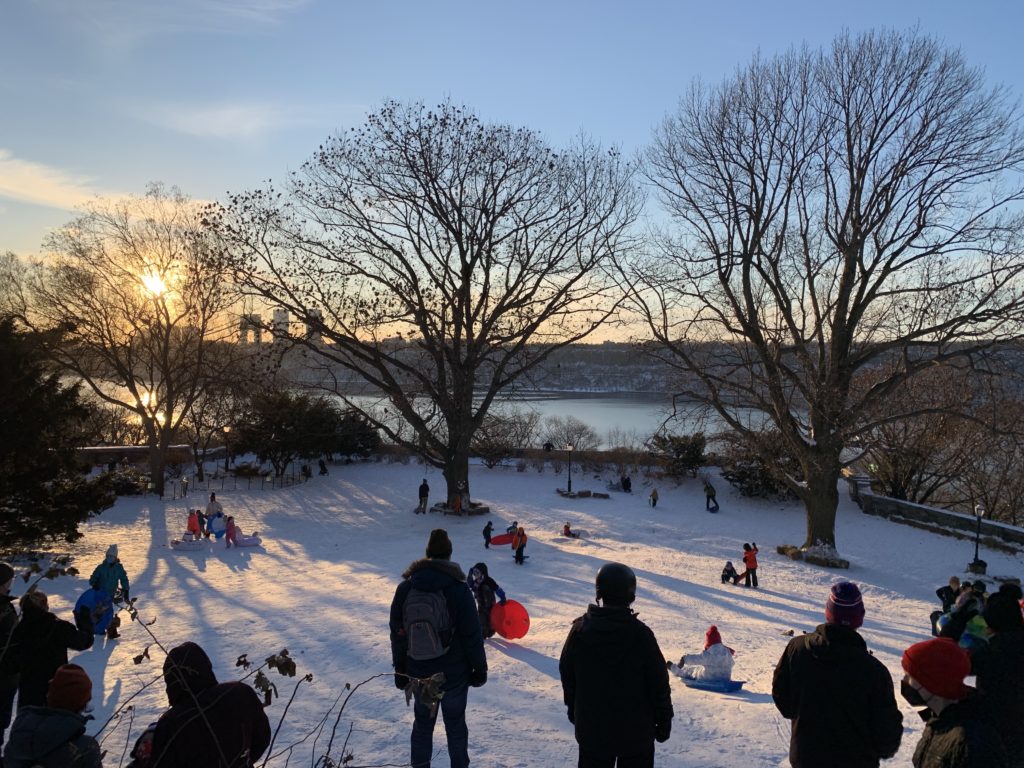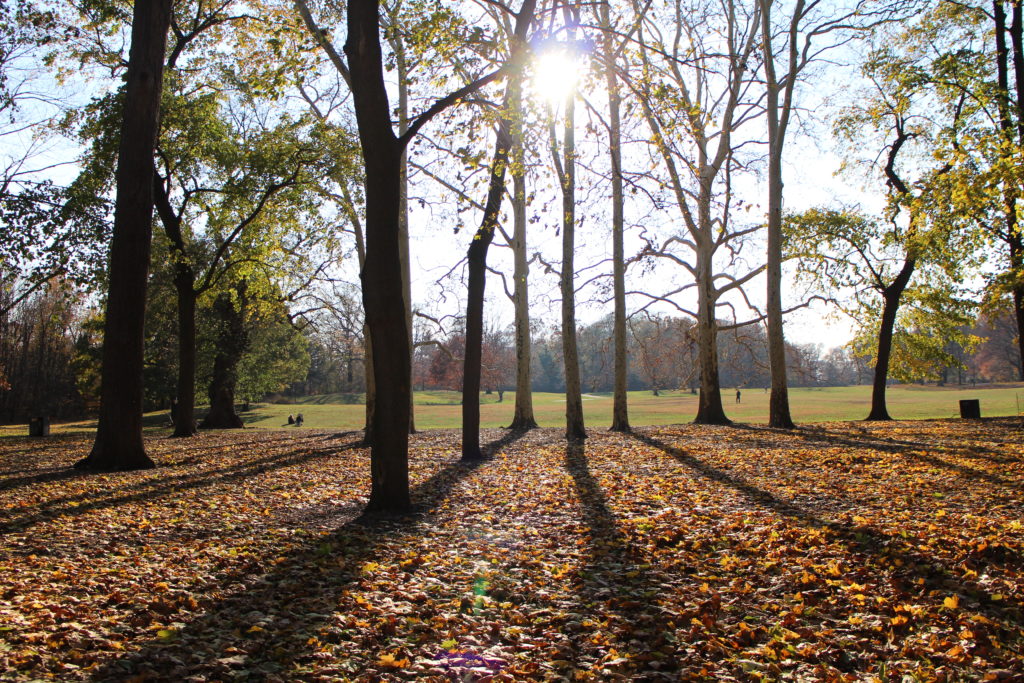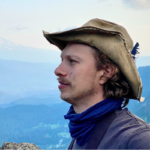
Billings Lawn at Fort Tryon Park. Photo courtesy of Ayumi Okada.
Landscape Music’s 2022 collaboration, Lungs of the City: Olmsted’s Parks in Music, is a program of new chamber music commemorating the bicentennial of the birth of Frederick Law Olmsted. Olmsted, the 19th century American landscape architect who laid the groundwork for today’s public parks, famously envisioned Central Park as “the lungs of the city.” This unique concert program explores that sentiment through musical investigations of Olmsted’s living legacy of vital urban landscapes across the United States, transporting listeners on a journey from New England to the Pacific Northwest.

Frederick Law Olmsted
In this post, we’ll get to know the program’s eight World Premiere works and their composers, who are all members of Landscape Music’s network, by exploring their landscape inspirations and creative approaches in their own words.
Juventas New Music Ensemble presents the first performance of this program on Saturday, March 26, 2022, at 8:00pm EDT at the Multicultural Arts Center in East Cambridge, MA. The event will also be available for free as a live broadcast on YouTube.
Several more performances of “Lungs of the City: Olmsted’s Parks in Music” will be presented by collaborating ensembles in cities in the Northeast and Midwest U.S. during the Spring, Summer, and Fall of 2022. American Wild Ensemble will perform free site-specific outdoor concerts in two of the Olmsted parks featured on the program: Fort Tryon Park, New York, NY, on May 27 at 6:30pm and Prospect Park in Brooklyn, NY, on May 28 at 12:00pm at the Audubon Center. Juventas New Music Ensemble will repeat the program at Frederick Law Olmsted National Historic Site in Brookline, MA, also the subject of a work on the concert, on Saturday, June 4, 2022 at 2:00 pm EDT. Michigan Technological University Department of Visual and Performing Arts will also present the program in Houghton, MI in October 2022, which will also be live-streamed online for free.
 Visit the project page for updates with more information about these events and additional concert dates as they are announced.
Visit the project page for updates with more information about these events and additional concert dates as they are announced.
“Lungs of the City” was co-curated and co-commissioned by Landscape Music in partnership with American Wild Ensemble, Juventas New Music Ensemble, and Michigan Technological University Department of Visual and Performing Arts. This project is proud to be a Celebration Partner of Olmsted 200.
* * *

Frederick Law Olmsted National Historic Site, known as Fairsted. Photo: NPS.
Frederick Law Olmsted National Historic Site, Brookline, MA
Ryan Suleiman, Piece of Mind
“Frederick Law Olmsted is considered the “father of landscape architecture” in the United States. Though not exactly a household name, his impact on his country was profound and his aesthetic was visionary in the nineteenth century, designing the first urban parks, including Central Park, Emerald Necklace, Stanford University’s campus, and many more. Contrary to the European aesthetic, Olmsted was keen on “listening” to nature. Though a park is by definition human-made, his designs focused on local landscapes and allowed them to be themselves. In crowded, noisy, stressful city-environments, he believed we all deserved a place to stop and take in nature.
Olmsted’s home and office, Fairsted (Brookline, MA), is where his firm operated, and this location – a park and creative studio – provides the inspiration for Piece of Mind. The piece is about stillness, contemplation, the creative process, and above all, letting sounds and silences simply be themselves.”
 The music of Ryan Suleiman engages with daydreams and the natural world – in particular, the simultaneity of sublime beauty and dread of living in our times. His work has been performed throughout the United States at such festivals as SICPP (New England Conservatory), June in Buffalo (NY), NANOworks Opera Workshop (Atlanta), and Snap Shot (San Francisco). He completed his Ph.D. at University of California, Davis and is currently Assistant Professor at Berklee College of Music in Boston. ryansuleiman.com
The music of Ryan Suleiman engages with daydreams and the natural world – in particular, the simultaneity of sublime beauty and dread of living in our times. His work has been performed throughout the United States at such festivals as SICPP (New England Conservatory), June in Buffalo (NY), NANOworks Opera Workshop (Atlanta), and Snap Shot (San Francisco). He completed his Ph.D. at University of California, Davis and is currently Assistant Professor at Berklee College of Music in Boston. ryansuleiman.com
* * *
The Emerald Necklace, Boston, MA
Oliver Caplan, The Emerald Necklace
“In 1880, Frederick Law Olmsted […] envisioned a ribbon of greenspaces winding through the city of Boston, Massachusetts and neighboring Brookline. The 7-mile linear route would ultimately connect the existing Boston Common and Public Garden to Franklin Park, with a series of new paths and parks, including The Fens, The Riverway and Jamaica Pond. The realized dream became known as the Emerald Necklace for its appearance on maps of Boston, like a string of green jewels. Today, the Emerald Necklace encompasses 1,100 acres of parkland, over half of the city’s park acreage.
When I first moved to Boston in 2004, the Emerald Necklace captured my imagination. It seemed almost a contradiction, to be in the heart of the city, yet able to walk for miles through wooded groves and along winding riverways. In Olmsted’s parks, I found peace, refuge and inspiration for my composing.
This piece is a love letter to a dear old friend, a remembrance of myriad moments in urban nature, from misty mornings to spring blooms.”
 Award-winning composer Oliver Caplan writes melodies that nourish our souls, offering a voice of hope in an uncertain world. Mr. Caplan’s works have been performed in over 175 performances nationwide. He has been commissioned by the Atlanta Chamber Players, Bella Piano Trio and Bronx Arts Ensemble, among others. Winner of a Special Citation for the American Prize in Orchestral Composition, additional recognitions include Veridian Symphony Competition Wins and the Fifth House Ensemble Competition Grand Prize. His 2017 album You Are Not Alone was featured on Apple Music’s Classical A-list and has been streamed over 200,000 times. Mr. Caplan is the Artistic Director of Juventas New Music Ensemble. olivercaplan.com
Award-winning composer Oliver Caplan writes melodies that nourish our souls, offering a voice of hope in an uncertain world. Mr. Caplan’s works have been performed in over 175 performances nationwide. He has been commissioned by the Atlanta Chamber Players, Bella Piano Trio and Bronx Arts Ensemble, among others. Winner of a Special Citation for the American Prize in Orchestral Composition, additional recognitions include Veridian Symphony Competition Wins and the Fifth House Ensemble Competition Grand Prize. His 2017 album You Are Not Alone was featured on Apple Music’s Classical A-list and has been streamed over 200,000 times. Mr. Caplan is the Artistic Director of Juventas New Music Ensemble. olivercaplan.com
* * *
Fort Tryon Park, New York, NY
Ayumi Okada, Golden Hour Walk at Fort Tryon Park
“When I heard of the project “Lungs of the City: Olmsted’s Parks in Music,” I immediately thought of portraying Fort Tryon Park as the subject of my composition. Fort Tryon Park is located in Washington Heights by the Hudson River. I have been a resident of New York City since 2009, but it was not until 2017, when I moved to Washington Heights, that I truly began to enjoy living in the city. The view of the sunset over the river above all is one of the most magnificent sights I have ever seen.
The immense beauty of the park designed by the Olmsted Brothers completely changed my perception of the busy city. Having daily access to the park gave me the comfort that I had been searching for for so long. I am grateful for this opportunity to show my gratitude toward the creators of this special park through my music.
Depicted in the piece is one of the most memorable walks I have taken in the park: a walk during the golden hour on a day after the winter solstice. The specific sites and views of the park featured in the piece include Heather Garden, Billings Lawn, Pine Lawn, and the views of The Palisades and the Hudson River.”

Ayumi Okada is a New York-based composer. Inspired by stories and natural landscapes, her music fuses traditional and modern sounds to create a unique compositional voice in the domains of concert and theatre. Her music has been performed by ensembles including Listen Closely, A.W. Duo, and Musica Verto Novo. Recent commissions include works for Lungs of the City and Abundant Silence. A native of Kyoto, Japan, she holds a degree from Mannes College of Music. ayumiokada.com
* * *

Prospect Park. Photo courtesy of Nell Shaw Cohen.
Prospect Park & Central Park, New York, NY
Nell Shaw Cohen, Breath of the Meadow, Heart of the Woodland
“Landscape architect Frederick Law Olmsted described urban parks as “the lungs of the city.” My music responds to Olmsted & Vaux’s expression of this metaphor through the iconic meadows and woodlands of New York City’s Prospect Park (1867) and Central Park (1858).
A lyrical theme, accompanied by sustained chords held against the flow of undulating triplets, opens and closes the piece. This music evokes the parks’ meadows, where the human body and the body of the landscape are connected through shared “breath.” Stepping off a busy sidewalk into these wide open spaces, the sensation of my lungs filling with fresh air feels like the echo of a gentle breeze blowing through treetops and grasses.
A middle section of syncopated rhythms and sinuous counterpoint recalls the parks’ winding woodland interiors, which reflect the “heart” of both visitor and landscape. These woodlands are spaces for contemplation and intimate conversation, where dense forest gives cover to an enigmatic network of footpaths.
Even as I cherish these two parks, I find their present-day terrain obfuscates a complex history. Seneca Village (1825-1857) was a vibrant Black community, which New York City’s government forcibly vacated in order to build Central Park. Both parks continue to occupy Lenapehoking: the unceded homeland of the Lenape.
The concept of parks as “lungs” may have come from Olmsted’s work in public health during the Civil War. Yet this idea feels strikingly poignant in our own time of pandemic and climate crisis, and has given inspiration and impetus to my music.”

Nell Shaw Cohen evokes landscapes, visual art, and the lives of mavericks in her lyrical works for concert, stage, and digital media. Commissions include Houston Grand Opera, Skylark Vocal Ensemble, Boston Choral Ensemble, Laura Strickling, and The Brass Project. Her operas have had workshops with Fort Worth Opera, The American Opera Project, New Dramatists, New York University, and University of New Mexico. She lives in New York’s Hudson Valley. nellshawcohen.com
* * *
Belle Isle, Detroit, MI
Libby Meyer, Beauty of the Fields
“The Key to all Improvements of Belle Isle must be found in the character of the existing wood.”
—Frederick Law Olmsted, The Park for Detroit
“Beauty of the Fields celebrates two native plants that are in abundance on Belle Isle and plants that Olmsted certainly would have valued as adding to the beauty and serenity of the park. Each section focuses on a different flower; flowers that attract and nourish bees, butterflies, birds and other wildlife as well as nourishing the spirit of visitors to the park.
1. asclepias tuberosa (butterfly weed): floating, fragile, fragrant, free, orange
![]() Butterfly weed is a beautiful orange flower that is a particular favorite of monarchs who float majestically over them feeding on their nectar.
Butterfly weed is a beautiful orange flower that is a particular favorite of monarchs who float majestically over them feeding on their nectar.
2. asclepias syriaca (common milkweed): buzzing, brilliant, busy, pink
Mostly known for their importance to the survival of the disappearing monarch butterfly, anyone who has ever stood in a field of milkweed knows that the flowers emit an intoxicating scent that attracts a symphony of honey bees, butterflies and hummingbirds. The movement is constructed in unconnected “moments”, each unique and fleeting.”

Libby Meyer‘s work reflects the natural rhythms and patterns of the world around her. Her music including chamber, orchestral, choral, wind symphony, film, dance and theater has been commissioned and performed throughout the U.S. Libby has served as Composer-in-Residence at Isle Royale National Park and the Visby International Center for Composers (Sweden). She holds a DMA in Music Composition from Northwestern University and is a Senior Lecturer in Music Theory/Composition at Michigan Technological University. libbymeyermusic.com
* * *
Olmsted Linear Park, Atlanta, GA
Michael-Thomas Foumai, Olmsted Gardens
“Olmsted Gardens takes inspiration from the Olmsted Linear Park in Druid Hills Georgia. The area known as Druid Hills was developed by Atlantan Joel Hurt of the Kirkwood Land Company. In 1890 Hurt persuaded Frederick Law Olmsted Sr. to prepare a plan for a residential suburb.
The work is in four movements, a kind of park tour of four of the seven park segments.
Beginning with Springdale, pastoral music, featuring the flute, paints a scenic gateway to the Linear Park, where visitors encounters a green knoll and a mature stand of oaks.
Shadyside is named for the heavily wooded section on the southern side of the western end, the music bristles with woodland creatures, with gestures of shadowy and lively activity.
Virgilee, is named after Joel Hurt’s daughter; this park is her memorial. The landscape of this segment continues the pastoral scheme and the music reflects the memorial tones with a solemn horn in remembrance.
Deepdene, the largest segment, forms the eastern end of the Linear Park. It is a wooded tract with a stream winding through its 22 acres. The final movement, a lively dance, celebrates the park in a winding stream of melodies and rhythm.”

Michael-Thomas Foumai is a composer of contemporary concert music, arranger, and educator whose work spans the avant-garde to the commercial. His concert music focuses on storytelling and the history, people, and culture of his Hawaiʻi home. Performances of his work include those given by Yannick Nézet-Séguin with the Philadelphia Orchestra, Lina Gonzalez-Granados with the National Symphony Orchestra, and Osmo Vänskä with the Minnesota Orchestra. michaelfoumai.com
* * *

Christina Rusnak in Forest Park. Photo courtesy of Christina Rusnak.
Forest Park, Portland, OR
Christina Rusnak, The Forest and the Architect
“In 1901, leaders in Portland Oregon, gathered to envision their city’s future. Portland hired Frederick Law Olmsted’s sons to design the city’s parks. John Charles Olmsted arrived by train in Portland in April 1903. Strategic, visionary planning was at the heart of the 1904 Olmsted report. Today virtually everyone in the city can easily walk to spacious and engaging parks.
As the vision’s cornerstone, Olmsted proposed that the densely wooded hills above northwest Portland be designated by the City as “a forest park.” The plans languished and Forest Park was plundered for over 40 years until advocates, and leaders committed to its completion in 1948. At 5,200 acres, it reigns as the largest urban forest in the United States and provides critical refuge for hundreds of native wildlife and plant species and acts as an important air and water filter. With more than 80 miles of trails, the park flanks the Tualatin Mountains, overlooking the city and the Willamette River providing invaluable access to nature, exercise, and educational opportunities. The Olmsteds’ contribution to this city is living, breathing and enduring.
I traverse the trails of Forest Park often. I sought to convey the forest’s inherent and contrasting elements – the sounds of the tiniest members of the forest’s inhabitants; the majesty of its towering trees; John Olmsted’s voice within the pages of the 1904 plan; trepidation as “progress” undermined the vision; the rebirth of the plan, and the joy of experiencing the park today as envisioned over a century ago.”
 Christina Rusnak passionately composes about place and the human experience. Ms. Rusnak has created many works for our national and cultural landscapes; her repertoire includes chamber, choral, orchestra, wind band, jazz, solo pieces, electro-acoustic works, and film. An advocate for New Music, she serves on the board of the International Alliance for Women in Music. Her works are available from Amazon, Naxos and Parma Recordings, with her scores available through her website. christinarusnak.com
Christina Rusnak passionately composes about place and the human experience. Ms. Rusnak has created many works for our national and cultural landscapes; her repertoire includes chamber, choral, orchestra, wind band, jazz, solo pieces, electro-acoustic works, and film. An advocate for New Music, she serves on the board of the International Alliance for Women in Music. Her works are available from Amazon, Naxos and Parma Recordings, with her scores available through her website. christinarusnak.com
* * *
Cal Anderson Park, Seattle, WA
Justin Ralls, Olmsted 200: Theme and Variations
“Olmsted 200: Theme and Variations was composed to commemorate the 200th anniversary of the birth of Frederick Law Olmsted Sr. The piece specifically commemorates the first Olmsted park in Seattle, Lincoln Park (later renamed Cal Anderson Park). Designed by the Olmsted firm (led by his son John C. Olmsted) between 1901 and 1904. The current urban park in Seattle’s Central District has changed over the years: like a palimpsest or theme and variations, each generation redefines the park for new needs and values.
The piece is measured in years beginning with the year of Olmsted’s birth, 1822. The theme passes through time, variations, and history, marking moments both for Olmsted and the park. Quotes of tunes, such as the Battle Hymn of the Republic, heard in the park during the revivalist meetings in the early 20th Century appear in counterpoint with a Black Lives Matter chant. During the historic protests after the murder of George Floyd, the park became the epicenter of nightly clashes between protestors and police, as well as hub for mutual aid and organizing. The park remains a communal, democratic, yet also contested space, reflecting the tensions, needs, dreams, and stories of the people. The theme, symbolizing Olmsted’s ideal, is contrasted with busy arpeggios and metric changes which speed through the years eventually to open up into a formless future: a democratic musical space where the ensemble is free to create their own variations and ending, symbolic of how Olmsted’s vision is bound to remain, yet change in perpetual theme and variation.”
 Justin Ralls, internationally recognized and award-winning composer, is inspired by the natural world: “a gifted melodist…a beautiful blend of natural and human-made music” (Artslandia), “impressive…showing a mastery of orchestral technique” (composer, John Adams), “definitely establishing his own voice” (SF Examiner). Ralls’ music engages ecologically and socially relevant themes in opera, orchestral, chamber, solo works, film music, and intercultural collaborations. He holds a Ph.D. in Music Composition, specializing in Nature, New Music, and Indigenous Thought. justinralls.com
Justin Ralls, internationally recognized and award-winning composer, is inspired by the natural world: “a gifted melodist…a beautiful blend of natural and human-made music” (Artslandia), “impressive…showing a mastery of orchestral technique” (composer, John Adams), “definitely establishing his own voice” (SF Examiner). Ralls’ music engages ecologically and socially relevant themes in opera, orchestral, chamber, solo works, film music, and intercultural collaborations. He holds a Ph.D. in Music Composition, specializing in Nature, New Music, and Indigenous Thought. justinralls.com
* * *

Locations referenced in Lungs of the City: Olmsted’s Parks in Music. Visit interactive map.
“Lungs of the City: Olmsted’s Parks in Music” is co-curated and co-commissioned by Landscape Music in partnership with American Wild Ensemble, Juventas New Music Ensemble, and Michigan Technological University Department of Visual and Performing Arts, and is a Celebration Partner of Olmsted 200.
Visit the project page for a list of concert dates.


